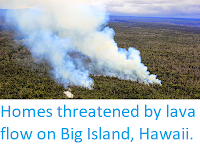Twenty three people have been injured, three of them seriously, after a lava bomb (chunk of lava thrown from a volcano, in either liquid or solid form) from Mount Kilauea struck a tour boat of the coast of Hawai'i on Monday 16 July 2018. The volcano began erupting from a new fissure on its eastern flank on 3
May 2018, since when a series of fissures have opened up, producing
several major lava flows, which have destroyed many homes and other
properties, and at least one of which has reached the sea, producing a
laze (toxic haze resulting from hot lava hitting water, producing
chemical-laden steam, which had led to the U.S. Coast Guard imposing a 50 m exclusion zone around areas of the coast that were being reached by the lava, though the boat struck by the lava bomb despite being outside this zone.
Damage to a tourist boat struckby a lava bomb off the coast of Hawai'i on 16 July 2018. Hawai'i Department of Land and Natural Resources.
The islands of Hawai'i have formed as a result of hotspot volcanism,
with a mantle plume hotspot currently located under Big Island, Hawai'i,
and each of
the other islands being the result of previous activity from the same
hotspot, with the oldest Islands in the northwest and newest in the
southeast. A volcanic hotspot is an area where magma from deep inside
the Earth is welling up through the overlying plate (in this case the
Pacific) to create volcanism at the surface. Volcanoes move as they
erupt, swelling as magma enters their chambers from bellow, then
shrinking as that magma is vented as lava.
The position of the Hawai'i Hotspot relative to the islands of Hawai'i. Joel Robinson/USGS/Wikimedia Commons.
See also...
Follow Sciency Thoughts on Facebook.








